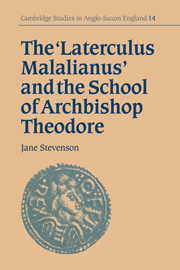Book contents
- Frontmatter
- Contents
- Preface
- List of abbreviations
- 1 Introduction
- 2 The contents of the Laterculus
- 3 Date and origin of the Laterculus
- 4 The nature of the Laterculus
- 5 Sources of the Laterculus
- 6 The Latinity of the Laterculus
- 7 Translational technique of the Laterculus
- 8 Manuscripts
- 9 Conclusion
- Text and Translation
- Commentary
- Appendix: Variant and anomalous biblical texts
- Bibliography
- Index of biblical sources
- General Index
4 - The nature of the Laterculus
Published online by Cambridge University Press: 20 March 2010
- Frontmatter
- Contents
- Preface
- List of abbreviations
- 1 Introduction
- 2 The contents of the Laterculus
- 3 Date and origin of the Laterculus
- 4 The nature of the Laterculus
- 5 Sources of the Laterculus
- 6 The Latinity of the Laterculus
- 7 Translational technique of the Laterculus
- 8 Manuscripts
- 9 Conclusion
- Text and Translation
- Commentary
- Appendix: Variant and anomalous biblical texts
- Bibliography
- Index of biblical sources
- General Index
Summary
John Malalas is not, by twentieth-century standards, a reliable or authoritative writer. Are we to conclude that the preservation and use of this rather inadequate chronographer casts an unfortunate light on the much praised school of Canterbury? This would probably be unfair. It is often stated that chronicles and histories are different types of text. In practice, modern students, perhaps especially those whose area of study includes such notable historians as Bede, find chronicles not simply different, but deeply unsatisfactory. There has been relatively little effort to understand the nature and purpose of a chronicle as such. Fortunately, the Chronographia of Malalas has recently been the subject of such a study. Croke argues:
The very pattern of content (wars, inventions, cosmic phenomena, natural disasters, imperial births, deaths and marriages, etc.) also had a long tradition, reflected originally in the local records of city states, then in chronicles as diverse as those of Apollodoros, the Parian marble, Phlegon and Jerome. There is, for the most part, a serious unifying element, namely that of public religious ceremonial or events of religious significance. Most of the events traditionally recorded in chronicles from Classical Athens to the time of Justinian and which form the backbone of Malalas's work were the great civic and imperial occasions. Even earthquakes and other prodigies gave rise to elaborate ceremony and ritual which is why they find a place in such a chronicle.
Croke further comments, ‘Chronicles in particular were works of reference and polemic while histories were for instruction and edification.’
- Type
- Chapter
- Information
- Publisher: Cambridge University PressPrint publication year: 1995



